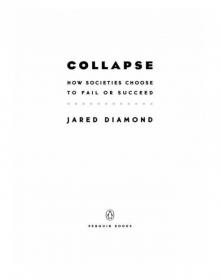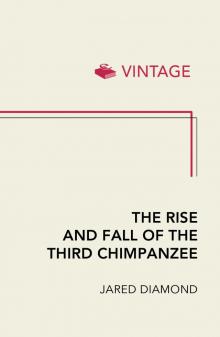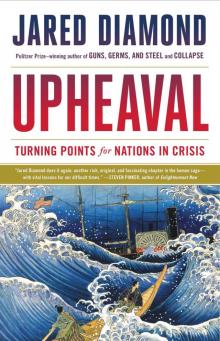- Home
- Jared Diamond
Upheaval: Turning Points for Nations in Crisis Page 12
Upheaval: Turning Points for Nations in Crisis Read online
Page 12
This reframing of innovations as supposedly retained traditions—the phenomenon of “invented traditions” often invoked by innovators in other countries besides Japan—contributed to the success of Meiji leaders in carrying out drastic changes. The cruel fact was that the leaders faced a dangerous situation when they assumed power in January 1868. Japan was at risk of attacks by foreign powers, at risk from the civil war between the bakufu’s opponents and its supporters, at risk of wars between domains, and at risk of revolts by groups threatened with losing their former rank and power. Abolition of the samurai’s privileges did provoke several samurai rebellions, the most serious of them the Satsuma revolt of 1877. Armed peasant uprisings did break out periodically in the 1870’s. But opposition to Meiji reforms turned out to be less violent than might have been anticipated. Meiji leaders proved skilled at buying off, co-opting, or reconciling their actual or potential opponents. For instance, Enomoto Takeaki, the admiral of the fleet that held out on Hokkaido against Meiji forces until 1869, ended up being absorbed into Meiji ranks as a cabinet minister and envoy.
Let’s now consider what selective changes actually became adopted in Meiji Japan. The changes affected most spheres of Japanese life: the arts, clothing, domestic politics, the economy, education, the emperor’s role, feudalism, foreign policy, government, hairstyles, ideology, law, the military, society, and technology. The most urgent changes, effected or launched within the first few years of the Meiji Era, were to create a modern national army, to abolish feudalism, to found a national system of education, and to secure income for the government by tax reform. Attention then shifted to reforming the law codes, designing a constitution, expanding overseas, and undoing the unequal treaties. In parallel with this attention to pressing practical matters, Meiji leaders also began to address the challenge of creating an explicit ideology to enlist the support of Japan’s citizens.
Military reform began with purchasing modern Western equipment, enlisting French and German officers to train the army, and (later) experimenting with French and British models to develop a modern Japanese navy. The result illustrates Meiji skill at selecting the best foreign model: instead of selecting just one foreign country’s armed forces as the model for all branches of the Japanese military, Japan ended up modeling its army on Germany’s army but modeling its navy on Britain’s navy (because in late 19th-century Europe Germany had the strongest army but Britain had the strongest navy!). As one example, when Japan wanted to learn how to build the fast battleships called battle-cruisers invented in Britain, Japan commissioned a British shipyard to design and build the first Japanese battle-cruiser, then used it as the model for building three more battle-cruisers in three different Japanese shipyards.
A national conscription law, adopted in 1873 and based on European models, provided for a national army of men armed with guns and serving for three years. Formerly, each feudal domain had had its own private militia of samurai swordsmen, useless in modern war but still a threat to the Japanese national government (Plate 3.4). Hence the samurai were first forbidden to carry swords or to administer private punishment, then hereditary occupations (including that of being a samurai) were abolished, then the ex-samurai were paid off in government stipends, and finally those stipends were converted to interest-bearing government bonds.
Another urgent order of business was to end feudalism. To make Japan strong required building a centralized Western-style state. That posed a delicate problem, because as of January 1868 the only real powers of the new imperial government were those just surrendered by the shogun; other powers remained with the daimyo (the feudal lords). Hence in March 1868 four daimyo, including those of Satsuma and Choshu who had instigated the Meiji Restoration, were persuaded to offer their lands and people to the emperor by an ambiguously worded document. When the emperor accepted that offer in July, the other daimyo were commanded to make the same offer, and as a sop they were then appointed as “governors” of their former feudal domains. Finally, in August 1871 the daimyo were told that their domains (and governorships) would now be swept away and replaced with centrally administered prefectures. But the daimyo were allowed to keep 10% of their former domains’ assessed incomes, while being relieved of the burden of all the expenses that they had formerly borne. Thus, within three-and-a-half years, centuries of Japanese feudalism were dismantled.
The emperor remained the emperor: that didn’t change. However, he was no longer cloistered in Kyoto’s Imperial Palace: he was transferred to the effective capital of Edo, renamed Tokyo. In his 45 years of rule, the emperor made 102 trips outside of Tokyo and around Japan, compared with a total of just three trips by all emperors combined during the 265 years of the Tokugawa Era (1603–1868).
Education was subject to big reforms, with big consequences. For the first time in its history, Japan acquired a national system of education. Compulsory elementary schools were established in 1872, followed by the founding of Japan’s first university in 1877, middle schools in 1881, and high schools in 1886. The school system at first followed the highly centralized French model, shifting in 1879 to the American school model of local control, and then in 1886 to a German model. The end result of that educational reform is that Japan today ties for having the world’s highest percentage of literate citizens (99%), despite also having the world’s most complicated and hard-to-learn writing system. While the new national system of education was thus inspired by the West, its proclaimed purposes were thoroughly Japanese: to make Japanese people loyal and patriotic citizens revering their emperor and imbued with a sense of national unity.
A more mundane but equally important purpose of educational reform was to train recruits for jobs in government, and to develop Japan’s human capital so that Japan could rise in the world and prosper. In the 1880’s, recruitment for the central government bureaucracy became based on an exam testing Western knowledge, rather than testing knowledge of Confucian philosophy. National education, along with the government’s official abolition of hereditary occupations, undermined Japan’s traditional class divisions, because now higher education rather than birth became the stepping-stone to high government office. Partly as a result, among the world’s 14 large rich democracies today, Japan is the one with the most equal division of wealth, and the one with proportionately the fewest billionaires in its population; the U.S. lies far at the opposite extreme in both respects.
The Meiji government’s remaining top priority was to devise an income stream to finance its government operations. Japan had never had Western-style national taxes. Instead, each daimyo had separately taxed his own lands to fund his own operating costs, while the shogun had similarly taxed just his own lands but also demanded additional money for specific purposes from all the daimyo. Yet the Meiji government had just relieved the ex-daimyo of their responsibilities as “governors,” had converted their ex-domains into prefectures, and had decreed that those prefectures would now be administered by the central government, leaving the ex-daimyo with no need (so said Meiji leaders) for revenues to finance administrative operations of their own. Hence the Meiji Finance Ministry reasoned that it now needed at least as much annual revenue as the shogun and all the daimyo combined had previously extracted. It achieved that aim in a Western manner, by imposing a national 3% land tax. Japanese farmers periodically complained and rioted, because they had to pay cash every year regardless of the size of the harvest. But they might have considered themselves lucky if they could have foreseen modern Western tax rates. For example, here in my state of California we pay a state 1% property tax, plus a state income tax of up to 12%, plus a national income tax of currently up to 44%.
Less urgent matters included substituting a Western-style legal system for Japan’s traditional system of justice. Law courts with appointed judges were introduced in 1871, followed by a Supreme Court in 1875. Criminal, commercial, and civil law reforms followed different paths of Westernization by experimenting with different foreign models. The criminal la
w code was initially reformed on a French model, then changed to a German model; the commercial law code used a German model; and the civil law code used French, British, and indigenous Japanese concepts before ending up as German-inspired. In each case, challenges influencing the choices included finding solutions compatible with Japanese views, plus adopting Western institutions in order to achieve international respectability necessary for revising the unequal treaties. For instance, that required abolishing traditional Japanese torture and broad use of the death penalty, which the West no longer considered respectable.
Modernization of Japan’s infrastructure began early in the Meiji Era. The year 1872 saw the founding of a national post system, and the building of Japan’s first railroad and its first telegraph line, followed by establishment of a national bank in 1873. Gas street lighting was installed in Tokyo. The government also got involved in Japan’s industrialization by setting up factories to produce bricks, cement, glass, machinery, and silk with Western machinery and methods. After Japan’s successful war of 1894–1895 against China, government industrial spending came to concentrate on war-related industries such as coal, electricity, gun factories, iron, steel, railroads, and shipyards.
Government reform was especially important if Japan was to achieve international respectability—and especially challenging. Cabinet government was introduced in 1885. Already in 1881, it had been announced that a constitution would be forthcoming, partly in response to public pressure. It then took eight years to devise a Western-style constitution in harmony with Japanese circumstances. The solution to that challenge depended on taking as a model not the U.S. constitution but the German constitution, because German emphasis on a strong emperor corresponded to Japanese conditions. Japan’s constitution invoked Japanese belief that its emperor was descended from the gods through an unbroken line of previous emperors extending back millennia in time. In a ceremony taking place in the imperial palace’s audience chamber, on a date (February 11) that was the 2,549th anniversary of the day traditionally associated with the empire’s founding, the emperor himself invoked his ancestors and presented the scroll of the new constitution to the prime minister, as the emperor’s gift to Japan. Present at the ceremony were representatives of the foreign diplomatic corps and foreign community, to make sure that they did not miss the point. Japan was now a civilized nation with a constitutional government, equal to the world’s other constitutional governments (and—hint hint—no longer to be singled out by unequal treaties).
Like other spheres of Japanese life, Japanese culture became a mosaic of new Western elements and traditional Japanese elements. Western clothing and hairstyles are overwhelmingly prevalent in Japan today and were adopted quickly—by Japanese men (Plates 3.5, 3.6). For instance, a group photograph taken of five members of the Iwakura Mission in 1872, only four years after the Meiji Restoration and only 19 years after Commodore Perry’s arrival, shows four of the members with Western suits, ties, top-hats, and hairstyle, and only one (Iwakura himself) still in Japanese robes and with his hair in a traditional Japanese top-knot (Plate 3.3). In the arts, traditional Japanese music, painting, woodblock prints, kabuki theater, and Noh plays survived alongside Western ballroom dancing, military bands, orchestras, operas, theater, painting, and novels.
Any nation risks falling apart if its citizens do not feel joined by some unifying national ideology. Each nation has its own familiar ideals and phrases responding to that task of creating a unifying ideology. For example, American ideals have included democracy, equality, freedom, liberty, and opportunity, as captured in phrases such as “rags to riches,” “melting pot,” “land of liberty,” “land of equal opportunity,” and “land of unlimited possibilities.” Particularly in newly independent countries such as Indonesia (Chapter 5), or in countries undergoing rapid change such as Meiji Japan, governments consciously formulate and promote unifying national ideologies. How did Meiji Japan do it?
The need for a unifying Meiji ideology was expressed in a widely circulated 1891 commentary on the emperor’s 1890 Rescript on Education: “Japan… is a small country. Since there are now those that swallow countries with impunity, we must consider the whole world our enemy… thus any true Japanese must have a sense of public duty, by which he values his life lightly as dust, advances spiritedly, and is ready to sacrifice himself for the sake of the nation.… The purpose of the Rescript is to strengthen the basis of the nation by cultivating the virtues of filiality and fraternal love, loyalty and sincerity, and to prepare for any emergency by nurturing the spirit of collective patriotism.… If we do not unite the people, fortifications and warships will not suffice. If we do unite them, then even a million formidable foes will be unable to harm us.”
In the last two decades of the Meiji Era, having dealt with mundane but urgent issues such as tax reform and law codes, the Meiji government was able to devote more attention to that task of imbuing Japanese with a sense of public duty. That was achieved partly by government support for traditional religion, and even more by government attention to education. Traditional Japanese religion served to unify Japanese people by teaching shared beliefs in the emperor’s divine descent, patriotism, civic duty, filial piety, respect for the gods, and love of country. Hence the government promoted the traditional Shinto religion and Confucian philosophy, subsidized the leading national Shinto shrines, and appointed their priests. Those values, associated with worship of the emperor as a living god, were featured prominently in the uniform national textbooks prescribed at every level of Japanese education.
Now that we’ve summarized the main components of selective change in Meiji Japan—other than changes in policies of overseas expansion, to be examined in the following pages—let’s reflect on Meiji changes and dispel some possible misunderstandings.
The goal of Meiji leaders was emphatically not to “Westernize” Japan, in the sense of converting it into a European society far from Europe—unlike Australia’s British colonists, whose goal was indeed to convert Australia into a British society far from Britain (Chapter 7). Instead, the Meiji goal was to adopt many Western features, but to modify them to suit Japanese circumstances, and to retain much of traditional Japan. Those adopted and modified Western features were grafted onto a Japanese core retained from Japanese history. For example, Japan didn’t need Europe as a model of literacy and urbanization: Tokugawa Japan already had high literacy, and the bakufu capital city Edo (renamed as Tokyo) was already the world’s largest city a century and a half before Commodore Perry’s arrival. Nor did Meiji Westernization consist of blindly imitating specific pieces of Western institutions: Meiji leaders operated from a remarkably clear overall understanding of Western society that underlay the Western military, educational, and other institutions adopted in Japan with modifications.
Meiji Japan was able to draw on many models. Those included multiple Western models: variously Britain, Germany, France, and the U.S. in different spheres. There were also many indigenous Japanese models on which to draw: late Tokugawa Japan consisted of 240 separate domains, differing in their tax policies and in other institutions. In addition to those positive models, Meiji Japan profited from an important negative model: China, whose fate of domination by the West made clear what Japan wanted to avoid.
Meiji reforms were directed at two different “audiences”: a domestic Japanese audience, and an overseas Western audience. On the one hand, the reforms were aimed at Japan itself: in order to strengthen the nation militarily and economically, and to imbue Japanese people with a unifying ideology. On the other hand, the reforms also aimed to make Western countries respect Japan as an equal, because Japan had now adopted Western institutions that the West respected. Those institutions included ones of basic governance such as a Western-style constitution and law codes; and ones of outward appearance, such as men’s Western clothing and hairstyles, and the emperor’s celebrating a Western-style wedding with a Western-style single wife, the empress. (Previous Japanese emperors had op
enly had many concubines.)
While Meiji leaders were in agreement on their overall goal of strengthening Japan so that it could resist the West, they did not start off with an encompassing blueprint. Instead, Meiji reforms were devised and adopted piecemeal in stages: first, creating a national army, an income stream, and a national system of education, and abolishing feudalism; then, a constitution, and civil and criminal law codes; and even later, overseas expansion by wars (to be discussed in the next pages). Nor were all of these reforms adopted smoothly and unanimously: there was internal conflict in Meiji Japan, such as the already mentioned samurai rebellions and peasant uprisings.
The remaining major line of selective change in the Meiji Era that we have not already considered was Japan’s transformation from being a target to being an agent of overseas expansion and military aggression. We saw that Tokugawa Japan isolated itself and had no aspirations of overseas conquests. In 1853 Japan appeared to be at imminent risk from militarily much stronger foreign powers.
By the beginning of the Meiji Era in 1868, however, Japan’s military reforms and industrial build-up had removed that imminent risk and permitted instead a stepwise expansion. The first step was Japan’s formal annexation, in 1869, of the northern island of Hokkaido, originally inhabited by a people (the Ainu) quite different from the Japanese, but already partly controlled by the bakufu. In 1874 a punitive military expedition was sent to the island of Taiwan, whose aborigines had killed dozens of Ryukyu fishermen. At the end of the expedition, however, Japan pulled back its forces and refrained from annexing Taiwan. In 1879 the Ryukyu Islands themselves (the archipelago several hundred miles south of Japan) were annexed. From 1894 to 1895 Meiji Japan fought and won its first overseas war, against China, and did annex Taiwan.

 Why Is Sex Fun?: The Evolution of Human Sexuality
Why Is Sex Fun?: The Evolution of Human Sexuality Guns, Germs, and Steel: The Fates of Human Societies
Guns, Germs, and Steel: The Fates of Human Societies Collapse: How Societies Choose to Fail or Succeed
Collapse: How Societies Choose to Fail or Succeed The Third Chimpanzee: The Evolution and Future of the Human Animal
The Third Chimpanzee: The Evolution and Future of the Human Animal The World Until Yesterday: What Can We Learn From Traditional Societies?
The World Until Yesterday: What Can We Learn From Traditional Societies? The Rise and Fall of the Third Chimpanzee
The Rise and Fall of the Third Chimpanzee Upheaval: Turning Points for Nations in Crisis
Upheaval: Turning Points for Nations in Crisis Guns, Germs, and Steel
Guns, Germs, and Steel The Third Chimpanzee for Young People
The Third Chimpanzee for Young People Why Is Sex Fun?
Why Is Sex Fun?